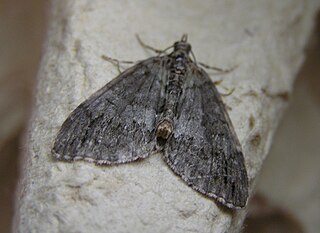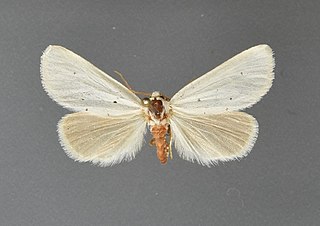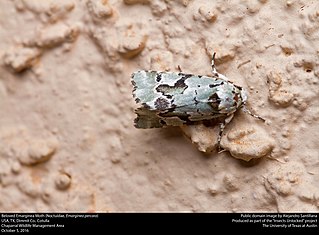
Idia is a genus of litter moths of the family Erebidae first described by Jacob Hübner in 1813.

Renia is a genus of litter moths of the family Erebidae erected by Achille Guenée in 1854.

Grotella is a genus of moths of the family Noctuidae first described by Leon F. Harvey in 1875.

Hyperstrotia is a genus of moths of the family Erebidae. The genus was erected by George Hampson in 1910.

Hydriomena is a genus of moths in the family Geometridae described by Jacob Hübner in 1825.

Grotella parvipuncta is a moth in the genus Grotella, of the family Noctuidae. The species was first described by William Barnes and James Halliday McDunnough in 1912. This moth species is found in North America, including New Mexico, its type location.
Schinia carolinensis is a moth of the family Noctuidae first described by William Barnes and James Halliday McDunnough in 1911. It is found in the United States from eastern North Carolina to the Florida peninsula and probably along the Gulf Coast.
Idia terrebralis is a species of litter moth of the family Erebidae first described by William Barnes and James Halliday McDunnough in 1912. It is found in North America, including Illinois.
Bleptina sangamonia is a species of moth of the family Erebidae first described by William Barnes and James Halliday McDunnough in 1912. It is found in the US from Illinois and Maryland, south to at least South Carolina, but it is not present in Pennsylvania, New Jersey and Delaware.
Alpheioides is a genus of snout moths. It was described by William Barnes and James Halliday McDunnough in 1912, and contains the species Alpheioides parvulalis. It is found in North America, including southern California, Arizona and Oklahoma.
Anemosella viridalis is a species of snout moth in the genus Anemosella. It was described by William Barnes and James Halliday McDunnough in 1912, and is known from Mexico and the US state of Arizona.
Decaturia is a monotypic snout moth genus. Its only species, Decaturia pectinalis, is found from California to southern Arizona. Both the genus and species were described by William Barnes of Decatur, Illinois, and James Halliday McDunnough in 1912.
Crambidia suffusa is a moth of the family Erebidae. It was described by William Barnes and James Halliday McDunnough in 1912. It is found in the US state of California.
Lycomorpha splendens is a moth of the family Erebidae. It was described by William Barnes and James Halliday McDunnough in 1912. It is found in North America, including Arizona, California, Nevada, New Mexico, Texas and Utah.
Givira cleopatra is a moth in the family Cossidae first described by William Barnes and James Halliday McDunnough in 1912. It is found in North America, where it has been recorded from Arizona, California, Nevada and Utah.
Thaumatopsis fieldella is a moth in the family Crambidae. It was described by William Barnes and James Halliday McDunnough in 1912. It is found in North America, where it has been recorded from California.
Lipocosma intermedialis is a moth in the family Crambidae first described by William Barnes and James Halliday McDunnough in 1912. It is found in North America, where it has been recorded from Texas and Maryland.

Eudonia spaldingalis is a moth in the family Crambidae. It was described by William Barnes and James Halliday McDunnough in 1912. It is found in North America, where it has been recorded from Alberta, Arizona, British Columbia, California, Colorado, Montana, Nevada, New Mexico, Utah and Wyoming.
Stiriini is a tribe of owlet moths in the family Noctuidae. There are at least 120 described species in Stiriini.

Psaphidini is a tribe of owlet moths in the family Noctuidae. There are at least 40 genera and at least 90 described species in Psaphidini.
This page is based on this
Wikipedia article Text is available under the
CC BY-SA 4.0 license; additional terms may apply.
Images, videos and audio are available under their respective licenses.






